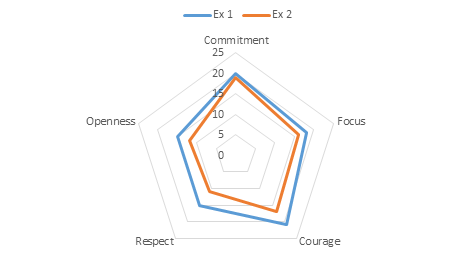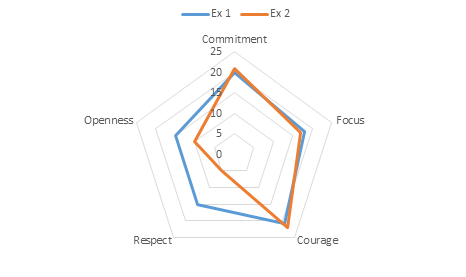Scrum Values
Use
The exercise is an opportunity not only to get a common understanding of the Scrum Values and evaluate how the team adheres to them but also to dig a little deeper in the context of transparency, inspection and adaptation - the three pillars of Scrum.
Length of time
Approximately 60 minutes
Short Description
The overall exercise consist of four parts. Don’t change the order of the sub-exercises ex #1 and #2. They seem very similar but look at the Scrum Values in your team from different angles.
- [5-10 min] Introduction
- [5 min] Exercise #1
- [5 min] Exercise #2
- [20-40 min] Results analysis and discussion
Materials
To start you will need a bunch of sticky notes and some pens. To visualize the results use either a whiteboard/flipchart or a projector/monitor and an app that allows creating radar charts (e.g. Excel).
Process
Introduction
This should be a quick chat to get a more or less common understanding of what each value means for everyone in the team. The purpose is not to dig deep (there will be time for that at the end of the exercise) but to make sure there are no big differences in how the team members understand each value (e.g. Focus might be misunderstood as not being “interrupted” at all while coding).
Exercise #1
The purpose of this exercise is to see how team members perceive the entire team adhering to each of the Scrum Values.
- Hand over a sticky note and a pen to each member of the team
- Ask everyone to rate on a scale of 1 (worst) to 5 (best) how good the entire team is in each of the five Scrum Values individually. That means it’s possible for instance to give a rate of 4 to each of the five Scrum Values. Any other combination of scores between 1 and 5 is also possible. Don’t use fractions, only integers.
- Give the team some time to think and then collect the sticky notes
Exercise #2
The second exercise is nearly identical as the first one with the only difference being how the scores are assigned. In ex #2 instead of rating each value individually team members will have to order them from the worst (1 point) to best (5 points). This is deliberately to overstress the differences between how each value was rated in ex #1 and bring into light problems that the team might consciously or unconsciously overlooked (e.g. in ex # 1 no Scrum Value got a lower score than 3 but in ex # 2 everyone ordered “Respect” as the worst value and “Openness” as the second-worst).
- Hand over one more sticky note to each member of the team
- Ask everyone to order all five Scrum Values by giving them a unique score between the worst (1 point) and the best (5 points). That means it’s possible to assign a given score to one and only one Scrum Value. Don’t use fractions, only integers.
- Give the team some time to think and then collect the sticky notes
Results analysis and discussion
The two exercises above should give good input for a discussion around the Scrum Values in your team and as mentioned before also in the context of Scrum’s three pillars: transparency, inspection, and adaptation. Be sure to sum up the scores for each exercise and visualize them (whiteboard/flipchart/Excel) in the form of a radar chart. Below are examples of radar charts for two hypothetical teams. The first team has pretty consistent results in both exercises. The second team however has much different scores in Respect and Openness between exercises #1 and #2 which doesn't guarantee but might suggest the team is not very comfortable with bringing those issues up or until now they were not aware those areas stand out. Be sure to discuss this difference in detail.
Team 1 – Consistent results between Ex #1 and #2
Team 2 – Big difference in Respect and Openness between Ex #1 and #2 might suggest an issue.
Source
Piotr Wegert originally posted at Scrum.org forum

